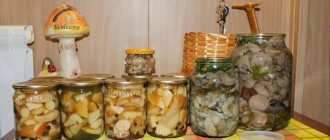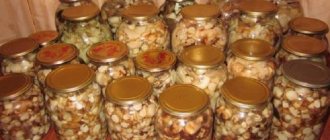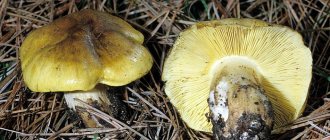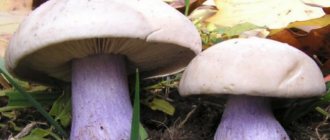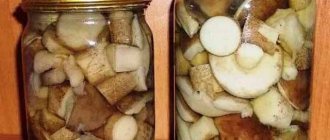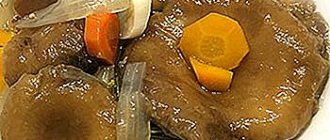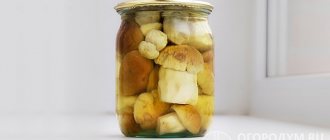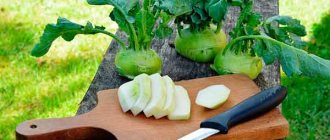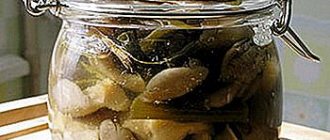Preparing for pickling poplar rows
Podtopolniki are not very popular among mushroom pickers.
However, those who are familiar with the taste of pickled sandpipers annually prepare the treat for future use. Harvest time is August-October. Spring varieties are harvested in May. The taste and safety of winter harvesting depend on the primary processing of freshly picked mushrooms. The main manipulations are carried out immediately after harvesting, since the row quickly becomes unusable.
Attention! Podtopolnik, which emits an unpleasant odor (similar to dust, rot), is a poisonous species. Such mushrooms should not be eaten.
Step-by-step instructions for preparing floodplains will help you avoid mistakes during the marinating process:
- It is necessary to sort through the mushrooms, remove damaged or spoiled specimens;
- for harvesting, select strong, fleshy fruiting bodies;
- sort the crop by size. Cut large caps into pieces;
- rinse with cold water;
- place the floodplains in a deep basin, fill with cold salted water. As a result, the bitterness will leave the mushroom body, the pulp will retain its color;
- leave the container in a cool, dark room to avoid fermentation;
- soak the collection for 1-1.5 days, regularly changing the water (every 4 hours);
- rinse everything again to get rid of sand and debris;
- clean the crop and cook for half an hour. Water should be salted at the rate of 10 g per liter of liquid;
- skim off foam during cooking;
- strain the floodwaters when they completely settle to the bottom of the pan;
- Rinse again under running water and dry.
Pickled poplar row
At the end of all procedures, the floodplains are completely ready for further marinating. The next step is to sterilize the containers and lids. These actions are mandatory, as they guarantee the safety of the quality of the workpiece.
Description and characteristics of edible species
The fungus sandpiper (podtopolnik) is one of the representatives of eukaryotes growing on loose soil. Some other species also love this soil: greenfinch (green grass), common oiler, fiddlehead (felt mushroom), pepper mushroom (pepper mushroom), chanterelle, saffron milk cap. Champignons can also settle on sand in the forest.
There are about 40 species of sandpipers in total. They also have a second name - rows. The most popular edible varieties of them, in addition to the topiary, include three: gray sandpiper, greenfinch, and red sandpiper.
- Gray sandpiper (gray row) is a conditionally edible mushroom. A characteristic feature is the mouse color of the cap. Suitable for eating only after soaking and boiling.
- Greenfinch - it cannot be confused with anything else because of the color of the cap and stem, which does not change even after prolonged heat treatment. Before use, the mushroom must also be soaked and boiled. The red sandpiper has a cap of the corresponding color, and its distinguishing feature is the yellow flesh, which emits a sour smell. Before cooking, soak in salted water for at least a day. It is boiled, fried, and salted.
Gray row
Red sandpiper
Greenfinch
The sandpiper mushroom (poplar row) belongs to the Ryadovkov family, or Trikholomova, the genus Ryadovok. Scientific name: Tricholoma populinum. Other names: sandstone, sandstone, poplar, podtopolnik, podtopolevik. Popular nicknames: bastards, frosts.
The sandpiper mushroom looks like this:
The cap has a diameter of 6 to 12 cm. At first it is slightly convex, hemispherical, with thin edges turned inward, then it straightens out and becomes fleshy. In wet weather it is slightly slippery, pinkish-brown in color, beige with brown splashes.
The hymenophore (back side of the cap) is lamellar. The membranes are thin and frequent. At a young age they are creamy or milky; over time they turn brown in sync with the cap.
The pulp when cut is elastic, white, soft, fleshy. Under the skin it is slightly reddish or brownish, and has a bitter floury taste. The mushroom is also easy to distinguish from other species by its characteristic aroma - a mixture of flour and fresh cucumber smells.
The leg is of medium length - up to 7 cm, thin, solid. Its thickness is 1.5–4 cm. The color can vary from milky to white. It has a scaly coating on it. When pressed, purple spots form.
A little history
This species was first described by the Danish botanist and mycologist Jacob Emmanuel Lange in 1933.
Video
Characteristics of sandpipers
This genus of mushrooms has up to fifty species, each of which has its own characteristics, but a generalized description of sandstone can be given.
Appearance and photo
Sandstone can be recognized by certain characteristics. Among them are:
- Spread in large groups.
- Growing in rows.
- The presence of a tubercle on the caps of old mushrooms.
- The habit of hiding in the sand or under leaves.
The most striking feature of the edible row is the flour aroma. You can see what sandstone looks like in the photo.
Morphology
The sandpiper's cap is convex, fleshy, and has the shape of a hemisphere. As it grows, it straightens and bends, acquiring an irregular shape. The edges of the cap are thin, curled, and cracked. In young individuals, the surface is slightly wet and slippery. The diameter of the cap is from 6 to 12 cm.
Depending on the species, it can have the following colors:
- green;
- grey;
- brown;
- red;
- shades of brown.
The leg is fleshy. In cross section it ranges from 1.5 to 4 cm, in length - from 3 to 8 cm. The color of the leg changes with age from shades of white to red-brown. When pressed, the surface of the leg darkens.
The plates of young mushrooms are white. With age they acquire a reddish-brown tint. The pulp of the row is thick, fleshy, white. Under the skin of the cap it is a little reddish, and under the skin of the stem it is grayish. Almost all types are characterized by a certain aroma, reminiscent of the smell of freshly ground flour.
Place of distribution
Sandstones grow in large families. Their rows can be found in the following places:
- coniferous forests;
- deciduous forests;
- parks;
- planting;
- roadsides.
Rows are most popular in the Omsk, Volgograd, and Saratov regions of Russia, Kazakhstan, and the Altai Territory. These areas are considered poor in mushrooms, so sandpipers are actively eaten here.
Edible or inedible
Rowers can be either edible or toxic. The following mushrooms are edible:
- black scaly;
- giant;
- dove;
- yellow-brown;
- massive;
- matsutake;
- Mongolian;
- red;
- poplar;
- grey;
- carved;
- earthy.
Commonly edible species include the silver, golden, booted, yellow-red, bearded sandpiper and greenfinch. All other representatives of the rows are inedible or toxic.
Difference from false mushrooms
Edible species are often confused with inedible or poisonous rowers. Below is a list of the most common false mushrooms with a description of the main differences.
| Species name | Features |
| Leopard |
|
| Mouse pointed |
|
| Soapy |
|
| Brown |
|
| White |
|
The main sign that sandstone is edible is its floury smell.
Collection rules and conditions
Sandstone begins to bear fruit in August. The last mushrooms are harvested in October, and some species survive until the first frost.
You can collect rows only in relatively environmentally friendly places. The fruiting bodies of mushrooms tend to absorb toxins from the external environment, as a result of which even edible species become poisonous. You can check mushrooms for toxicity in a fairly simple way: if the flesh of the sandpiper is white, it is suitable for consumption, yellow flesh indicates unsuitability.
There are more than 40 types of sandstones in nature. But the following types are considered the most common:
- Greenfinch is a sandpiper with an unusual green color. Even after heat treatment, the color does not change. Sometimes there are specimens with a yellowish tint. This species belongs to the conditionally edible category. It is eaten only if complex preparation technology is followed and in very limited quantities. The cap is convex and has a small tubercle in the middle.
As they grow older, scales appear on the surface. The leg of the greenfinch is short but wide. It has a dense elastic texture. The color of the legs is also green. The lemon-colored plates have the characteristic smell of flour in the rows. The pulp is white. In overripe or spoiled specimens, it acquires a yellow tint. Gray sandstone poses a threat to human health if eaten raw. Despite belonging to the category of edible, it becomes so only after heat treatment. The cap is fleshy and round. Over time, it acquires a flat shape and uneven edges. The cap is slightly flattened and has a tubercle in the middle.
Gray row
The surface is painted with an ashen shade of gray. The leg is whitish, sometimes with a gray-yellow tint. Initially white plates become yellow or gray over time. The pulp is white. When broken, it turns yellow, emitting a powdery odor. Red sandstone – different sources fall into different categories. Some describe this species as edible, others classify them as conditionally edible. One way or another, but, by analogy with gray sandstones, red ones can be eaten only after processing. The cap is convex, and as it matures it takes on a flat shape. There is a small bump in the middle.
Red Sandstone
How to pickle mushrooms for the winter
The technology for preserving pickled poplars is conventionally divided into two main methods: cold and hot. The first one requires a lot of time (more than 1.5 months), but the preparation has better taste, the fruit body retains dense pulp. In this case, the poplar should be blanched to get rid of bitterness.
The hot preparation method is more popular, since you can get the finished dish in just a few days. Mushrooms have delicate flesh and are absolutely safe. Marinating floodplains does not require expensive components or special equipment, as confirmed by the following video:
The conservation process for sandpipers varies. In some recipes, mushrooms are boiled in salted water and then left to pour. Others involve cooking in a ready-made marinade, which allows you to preserve a more intense mushroom aroma.
The floodplains should be placed tightly in the jar, being careful not to damage the caps. Remaining air cushions between pieces of pulp can cause fermentation. Fill the jar with pickled sandpipers to the very neck, as indicated in the photo.
How to cook sandbox mushrooms in a frying pan
The only drawback of these mushrooms is that they grow on sandy soils, so careful preliminary preparation is indispensable. The collected sandboxes need to be rinsed well and soaked in salted cold water for at least 3-4 hours, and preferably overnight. But the water needs to be changed periodically so that the sandpipers do not become sour. During this time, the plates and pores will open and the grains of sand will sink to the bottom. The easiest way is to simply fry the prepared mushrooms in a frying pan.
- Cook for 20 minutes from the moment of boiling, removing the foam.
- Rinse and leave to remove excess liquid.
- Place the mushrooms in a heated frying pan with oil. Fry.
- At the end of cooking, add salt, spices, pepper to taste. Cook for another 2 minutes.
Serve with potatoes or other side dish.
Terms and conditions of storage of pickled poplars
The snack can be eaten after 30-40 days, from the moment of marinating. The workpiece, sealed with plastic or glass lids, is edible for 12-18 months, with tin lids - 10-12 months.
Advice! To avoid oxidation of the lid and spoilage of the snack, you should give preference to plastic or glass material.
Storage conditions for pickled floodplains:
- dry, ventilated room;
- air temperature +8-10 °C;
- no direct sunlight.
Compliance with the technological process, the use of sterilized utensils, as well as ensuring optimal storage conditions guarantee the preservation of the taste properties and quality of pickled floodplains.
How to pickle mushrooms for the winter
There are many recipes for delicious pickling of subtopolniks, which differ from each other not only in the set of additional ingredients, but also in the preparation options. Mushrooms are salted in 2 ways: hot and cold.
Hot salting of floodplains
The advantages of the hot salting method are obvious:
- the product does not need to be soaked for several days;
- the period of salting of floodplains is from 7 to 14 days;
- The preparations can be stored for up to 8 months.
You can add horseradish root to the pickling for a sharp and piquant taste.
To salt the floodplains in jars using the hot method you will need:
- poplar row – 2 kg;
- salt – 80 g;
- laurel leaves – 6 pcs.;
- black pepper (peas) – 10 pcs.;
- cloves – 6 pcs.;
- garlic – 6 cloves;
- dill.
Steps:
- Wash the sunflowers well and cook in lightly salted water for 30-35 minutes.
- Drain the water, rinse the rows and place in a colander.
- Meanwhile, sterilize the jars and place dill, a couple of cloves of garlic and sandpipers (caps down) on the bottom of the glass containers.
- Lay the floodplains in layers, sprinkling with salt and adding spices.
- Add salt as the last layer, place the weight and “forget” about the preparations for 2 weeks.
Advice! To add spiciness and piquant flavor, you can add peeled horseradish root to the preserves. However, its amount should not exceed more than 20 g per 1 kg of mushrooms.
Cold salting of floodplains
Cold salting allows you to preserve most of the vitamins and elasticity of the structure. The result is “neat” crispy mushrooms that can decorate any feast.
Cold salting of floodplains is distinguished by the fact that it does not require cooking, but more attention must be paid to the preliminary preparation of forest raw materials.
Sandpipers are cleaned of dirt, pine needles and moss, washed in clean water and the lower part of the leg is cut off. Then place it in a container, fill it with cold water and leave for 1.5-2 days. The fluid is changed every 6-8 hours. After 2 days, the floodplains are washed well and placed in a colander to dry a little. If necessary, use a paper towel or napkins.
Required:
- undertopolniks – 5 kg;
- salt – 180 g;
- bay leaf - to taste;
- black pepper (peas) – 15 pcs.;
- garlic – 9-12 cloves.
Before salting, the rows must be soaked for 2 days
Cooking process:
- Garlic is placed at the bottom of pre-sterilized jars.
- Then the floodplains are laid out in layers.
- Each layer is salted and topped with garlic and spices.
- The last layer is salt, bay leaf and 1-2 garlic cloves.
- A pressure is placed on top, after which the mushrooms are stored in a cool room for 1 month.
After a month, you need to check and make sure that there is enough brine and it covers the rows completely. If it is not enough, you can add cold boiled water.
Podtopolniki are served with unrefined vegetable oil and finely chopped onions.
Is it possible to grow floodplain yourself?
It is suitable for cultivation and breeding in artificial conditions - both indoors and outdoors. The technique is simple, you just need to follow a few technological rules. On a farm scale, almost no one does this, since the mushroom is not in great demand. However, amateurs can grow this variety for themselves if they wish.
The most important conditions are the required temperature and sufficient humidity. Poplar row fruits set at a temperature of no more than 15 °C. Such an environment can be created in a basement or cellar. However, it is better to breed sandpipers outdoors.
The process must contain the following phases:
- First you need to make a substrate. To do this, combine 50 g of mycelium, a liter of water, 100 g of chalk and 5 kg of soil (preferably a turf layer of soil with rotted twigs, taken under a poplar).
- Pour the mixture into boxes or boxes, add 5 cm of wet soil on top.
- The soil with mycelium is laid out on the beds, and everything is covered with film to maintain high humidity.
- The best temperature for mycelium germination is 20 °C.
- When the soil is overgrown with it, the film is removed and the substrate is transferred to the shade. The first mushrooms will appear in a month and a half.
- After harvesting, the soil is moistened, then soil is added.
- Before winter frosts, the area with mycelium is covered with leaves or grass.
- In the spring, when the air temperature reaches 10 °C, the beds are opened.
How to prepare floodplains for salting
Podtopolniki have a pleasant, slightly sweet taste and light aroma. The mushrooms themselves are fleshy and medium-sized. The caps of adult specimens reach 18 cm in diameter.
Podtopolniks are classified as conditionally edible species, which means they require more attention when processing them. The row is collected from the second ten days of August to the beginning of October. As a rule, their mycelium is large, so collecting almost the entire basket in one place is not difficult.
You can determine the age of mushrooms by the cap. In adult specimens, the lamellar part is brown-red in color; in young subtopolids, the plates are white and pink. The preparations use the whole mushroom. The legs of the rows are distinguished by their fleshiness, therefore, like the caps, they are preserved.
You can collect rows from August to October
Before preparation, floodplains are cleared of forest debris: pine needles, moss, grass, soil. It is more convenient to do this with a brush or a dry soft cloth. Then the rows are sorted out, separating wormy and too old specimens. After this, the floodplains must be soaked.
The soaking procedure lasts from 2 to 3 days. Podtopolniki are placed in a basin and filled with plenty of cold water. The fluid is changed every 6-8 hours. They do this in order to get rid of the bitterness that is inherent in floodplains.
Before cooking, the sandbox is checked. If after soaking it becomes elastic and stronger (does not break when pressed), then it can be used in canning or cooking.
Podtopolniki are fried, boiled, salted and pickled. In any case, they are a great addition to both a family lunch and a holiday dinner. However, salting is one of the most popular ways of preparing sandboxes.
Warning! Floodpolks have the ability to absorb harmful elements from the environment, so the collection location is critical.
Most common types
In total, there are about 40 species of sandpipers, which have another name - rowers. They come in different colors - from grayish to brown. But there are only three most popular ones.
Greenfinch
The main difference between this species is its green color. It does not change even after prolonged heat treatment. The mushroom is edible, but in small doses and after soaking and cooking. You can add it to any dish. Bonus - it can be found before the first snow.
Gray sandpiper
Edible, gray in color. It is suitable for consumption after heat treatment. Dangerous in its raw form.
Red sandpiper
Conditionally edible - only after long and proper preparation it is suitable for consumption. It is red in color and has yellow flesh. Before cooking, soak in a saline solution for at least a day, then you can pickle, fry or boil.
A simple recipe for making marinated subtopolniks...
To pickle poplar row in a simple way, you need to prepare the following ingredients:
- Podtopolniki.
- 2 tbsp granulated sugar.
- 2 tbsp rock salt.
- 3 tsp vinegar essence.
- 10 peppercorns.
- Bay leaf.
- 6 pcs cloves.
- Dill umbrellas.
The amount of spices is indicated for one liter of marinade.
Cooking process
- The mushrooms must be completely cleaned of dirt, washed several times, then filled with cold water and left for 2 days. Don't forget to change the water twice a day. Thanks to this procedure, you can get rid of bitterness. Podtopolniki need to be soaked in a cold place, otherwise they may turn sour. When two days have passed, you need to rinse the mushrooms again and remove the mucous membrane with a brush.
- Place the prepared row into an enamel container with salted water. Place on the stove and cook over medium heat for 15 minutes.
- Then you need to change the water and cook the mushrooms for another 40 minutes.
- When the floodplains are ready, they need to be placed in a colander.
- For one bucket of mushrooms you will need to prepare 1.5 liters of brine. Fill the pan with water, bring it to a boil and add sugar, salt, spices, bay leaf, dill umbrellas. Boil the marinade for 15 minutes, then add the vinegar essence and after 5 minutes remove from heat.
- Place the row, caps down, in sterilized jars. Fill with marinade to the very top and seal with a seaming machine.
- When the workpiece has cooled, it must be placed in the refrigerator.
It will be possible to serve the appetizer to the table in a month.
If you managed to collect floodplains, then you now know how to prepare them for the winter.
- Number of servings: 2
- Preparation time: 20 minutes
- Cooking time: 20 minutes
What can you cook from them?
Sandbox is versatile in preparation - marinate, boil, salt, dry, fry. The only condition is to prepare this mushroom.
You need to process it like this:
- rinse each specimen under cold water;
- put the mushrooms in a deep bowl so that you can easily mix them;
- fill with very salty water and leave overnight;
- In the morning we mix the contents - the pores in the row have opened and sand will easily come out;
- carefully take out the mushrooms so as not to pick up fallen sand from the bottom;
- rinse again and fill with clean water;
- put on fire and after boiling, cook for 30 minutes;
- We change the water again and we can cook at our discretion.
How to cook
Have to take:
- sandpipers - 1 kg;
- water - 1 l;
- salt - 1 tsp;
- cloves - 2 pcs.;
- citric acid - on the tip of a knife.
Read also VGB in rabbits: symptoms and treatment
How to cook:
- We pre-prepare the product.
- Pour water into the vessel, add salt, citric acid and bring to a boil.
- Place the sandboxes into boiling water.
- Cook for 20 minutes in a covered pan.
- Add seasonings and cook for another 20 minutes.
How to salt
You will need:
- sandpipers - 1 kg;
- garlic - 4 cloves;
- currant leaves - 6 pieces per 1 jar;
- pepper - 10 peas;
- salt - 50 g.
How to cook:
- Place washed currant leaves in sterilized jars.
- We lay out the pre-prepared mushrooms in dense layers, sprinkling each one with salt and chopped garlic.
- You also need to cover the mushrooms with leaves on top to prevent them from becoming moldy.
- We close the jars and wait at least 6 weeks.
How to marinate
Needed:
- sandpipers - 1 kg;
- vinegar 6% - 3 tbsp. l.;
- sugar - 1 tbsp. l. with a slide;
- pepper - 5 peas;
- salt - 50 g;
- cloves and bay leaves - 2 pcs.
How to cook:
- Place the pre-prepared mushrooms in a saucepan and cook over low heat.
- Add all the ingredients.
- Keep on fire for another 20 minutes.
- Place the mushrooms tightly into the prepared jars.
- We close the jars and wait for them to cool, after which we store them in a cold room.
So, sandpipers are edible mushrooms that, when properly processed, can be a great snack. They can be confused with other species, so you need to collect them carefully and carefully. In addition to appearance, focus on the floury smell - you definitely won’t go wrong.
Sandpipers are lamellar mushrooms of the genus Ryadovka of the family Ryadovaceae (Tricholomaceae), widespread in our forests. They are also known as sandstones, rows, and floodplains. The mushrooms received such names because of their love for sandy soils, their ability to grow in a row, and in addition, they prefer poplars over other trees.
With added olive oil
There are several answers to the question of how to marinate pigs. One of them will be a recipe for preparing winter snacks with the addition of olive oil. Such mushrooms turn out to be especially tender and tasty.
Prepare:
- 750 ml olive oil.
- 500 ml vinegar (it is better to give preference to wine vinegar).
- 2 tablespoons salt.
- 4 bay leaves.
- 6 clove buds.
- 6 black peppercorns.
Place the prepared pigs into a saucepan, add water, vinegar and a little salt. This mixture must be boiled for 10 minutes. After this, the liquid can be drained.
Place the pigs into pre-sterilized jars. They should be laid out in layers, alternating with spices. At the very end, pour olive oil into each jar. Seal the jars tightly with sterilized lids. This dish, prepared for the winter, should be stored in the refrigerator. This recipe will help you prepare a dish that your family and all your guests will surely enjoy.
Is it possible to confuse: twin mushrooms
There are many species of sandpipers in the family that are not only inedible, but also poisonous. Some of them have their own distinctive features, which can be used to identify a bad mushroom.
Let's look at the most common types:
- leopard row is similar to the earthy row, but is very toxic, it has white mouse plates and characteristic spots on its cap; the mushroom does not have a floury taste and smell, like the edible species;
- mouse pointed row is a low-toxic species, but should not be consumed. Can be recognized by the dark protruding sharp hump in the middle of the cap. It has no odor; old mushrooms have yellow spots;
- soap row is the type that is most often confused with edible. It has a fruity-soapy, not very pleasant smell, the flesh turns red when cut;
- brown row - a dark mushroom with a brown tint, turns red when cut, has an unpleasant odor;
- the white row reaches 8 cm in height, has a flat, outstretched cap with wavy thick edges, turns pink when cut, has a pungent smell of radish.
Where and how to collect mushrooms?
Podtopoleviki can be found even within the city - in parks where their favorite trees grow, even along highways. But it is recommended to collect mushrooms in a clean place: in open spaces, forest plantations, groves. When going “hunting”, you should pay attention to raised mounds of soil or foliage, from under which caps are visible. Where one mushroom is found, there will certainly be others from the colony.
Sandpipers hide carefully. It takes a lot of effort to find protruding caps in fallen leaves. When the mushrooms are found, the dirt, opal, pine needles or sand are carefully raked and the mushroom is removed. It is cut off with a knife. This is important, because if assembled incorrectly, there is a risk of damaging the root system (mycelium). Then the harvest will be ruined throughout the surrounding area.
An experienced mushroom picker will tell you how to look for and collect cottonwood. Watch the video:
How to prepare mushrooms for pickling?
The key to success in preparing winter snacks will be not only the correct recipe, but also proper preparation of the pigs. After you have brought mushrooms from the forest, you need to sort them out. Remove rotten and wormy specimens. Then the pigs need to be washed thoroughly. If there is a lot of debris stuck to them, soak the mushrooms in water for a while before cleaning. After this they can be easily cleaned.
Cleaned pigs need to be filled with cool water and soaked for about an hour. After this, cut them into pieces, place them in a saucepan, cover with water and boil for 25 minutes. During this time, the mushrooms should turn black.
Edibility
Sandpipers are in the edible category. They can be pickled, fried, boiled, stewed and salted.
The only negative is that the soil in which they grow often stains them, so you need to carefully treat the product before use. But this process is worth the finished result - the dishes turn out tasty and aromatic.
Botanical description
The mushroom also has the following names: sandstone, poplar, poplar row, poplar and poplar.
hat
At first it is convex in the middle and with the edges turned inward. As the hat grows, it straightens and bends inward. It is fleshy, and in high humidity or after rain it becomes slippery and acquires a light brown color. The diameter can reach 12 cm. The flesh of the cap is reddish.
Records
They are frequent and thin. At first they are white and cream in color, and then, along with the cap, they begin to turn brown.
Leg
Small and thin - up to 7 cm. Color can vary from white to milky. The inside is solid and fleshy. There is a small scaly coating on the outside.
Pulp
White, soft, fleshy, elastic. Under the skin it has a brownish tint, floury and bitter taste.
Pickled podtopolniki for the winter. How to pickle mushrooms for the winter
First of all, let's look at the recipe for pickling poplar row.
Important! Before cooking, mushrooms must be peeled, washed, and then soaked for several days, periodically changing the water.
For 1 liter of marinade we will need the following ingredients:
- 1 tbsp white sugar.
- 2 tbsp table salt.
- 60 ml table vinegar.
- Spices according to preference (peppercorns, cloves, garlic, dill umbrellas, bay leaf).
Pickling process
It is assumed that you have already prepared the floodplains, that is, soaked them for 2-3 days. Large mushrooms need to be chopped. Then they need to be placed in an enamel pan, filled with cold water and placed on the stove. Bring to a boil, skim off the foam and remove from the stove. As a result of cooking, the volume of mushrooms should decrease by 2-3 times. Remove the row using a slotted spoon and place in a separate container.
To prepare the marinade, add sugar, two heaped tablespoons of salt and spices to a saucepan with water. Boil. After that, add the mushrooms to the marinade and cook for 20 minutes. 5 minutes before cooking, add vinegar and chopped garlic.
After this, place the mushrooms in sterilized jars up to the shoulders, fill to the top with marinade, and roll up the lids with a special machine.
Place the workpiece upside down in a dark place and cover with a towel. When it cools down, put it in the cellar or pantry for storage. After 1 month you can take a sample.
cooking method
Rinse the mushrooms well and soak for 3–5 hours, or for a day, changing the water several times a day. After this, put the mushrooms in water; as soon as the water boils, add salt, enough to taste good. Boil the mushrooms for 35-40 minutes. Remove from heat and rinse well under running cold water. Marinade: Add all ingredients. Place on the fire, once it boils, add the mushrooms to the marinade and simmer for 20 minutes. Pour hot water into clean jars and microwave for 5 minutes. for sterilization. Boil the lids separately in a saucepan with water for about 5 minutes. Everything can be laid out with mushrooms and rolled up. The mushrooms are spicy and very tasty. Bon appetit.
- Author: Maria Sukhorukikh
Rate this article:
- 5
- 4
- 3
- 2
- 1
(0 votes, average: 0 out of 5)
Share with your friends!
What do pigs look like and where to collect them?
There are two main types of these mushrooms:
- The pig is fat. Such mushrooms are most often found on the stumps of coniferous trees. You can start collecting them in the first month of summer. They are characterized by a large cap, the diameter of which can reach 20 cm. As a rule, it has a reddish-brown color. Below you can notice thin plates of a yellowish tint. If the cap is broken, the fracture site begins to darken in the air. The pig's leg is short and dense. Often it has a curved shape. This type of mushroom is still considered inedible, so it is not recommended to eat it.
- The pig is thin. Such mushrooms can be found near spruce, poplar and birch trees. They are characterized by a large fleshy cap, the diameter of which can reach 10 cm. In young mushrooms, the cap has a flat shape. As the mushroom matures, the cap becomes funnel-shaped. The mushroom stem is short and has a lighter color compared to the cap. It is this type of pork that is best suited for marinating at home. The main thing is to choose the right recipe and strictly follow it.
Sandpiper mushrooms with potatoes
- mushrooms – 400 g;
- potatoes – 4 pcs.;
- butter – 50 g;
- onion – 1 pc.;
- salt and spices;
- dill - a bunch.
Instead of butter, you can use vegetable oil, but then the taste of the dish will be slightly different.
- Boil the mushrooms. Large specimens should be cut into several pieces.
- Cut the potatoes into cubes and boil until half cooked.
- Combine ingredients, add salt and pepper.
- Fry mushrooms and potatoes in butter.
- Separately, fry the onion and add to the mushrooms.
Sprinkle the finished dish with chopped dill. You don’t have to boil the ingredients, but fry them immediately, but in this case the dish will definitely not turn out to be dietary.
Sandpipers are tasty and nutritious mushrooms that can be used to prepare many delicious snacks and dishes.
Podtopolniki are little-known mushrooms, so only experienced mushroom pickers know about them. They are common in Siberia. From the name it is clear that they grow in close proximity to the poplar. Mushrooms have a fleshy cap and legs, have a high nutritional value, and therefore satisfy you for a long time.
Some housewives make blanks from poplar rows. Before cooking, they must be soaked, as they absorb harmful environmental substances. Picking mushrooms near the road is not recommended, as they can cause eating disorders and even poisoning.
In previous articles you could familiarize yourself with recipes for preparing honey mushrooms for the winter. Now let's look at recipes for salting and pickling poplar rows.
So, if you have collected mushrooms, then familiarize yourself with the methods of preparing them.
Where and when do sandpipers grow?
Sandpiper belongs to the lamellar mushrooms, which reproduce by spores located in the plates. They grow in large groups, lining up in a kind of arc - from older, tall mushrooms to younger ones. If there is a small obstacle on the way - a log or a stump - the mushrooms easily bypass it. Sometimes sandpipers gather in so-called “witch rings.” Circles of different diameters (this is how the mycelium is located) can be found in open areas and in the shade of trees. Colonies are always large.
The distribution range of sandpipers is quite narrow. They grow in deciduous plantings, pine forests and under poplars (usually), preferring sandy soils. Mushrooms hide from prying eyes under layers of sand, grass and pine needles. Row trees are common in countries with temperate climates, in Canada, the USA, Europe, Central Asia - where poplars can be found. In Russia, sandstones are found in steppe regions:
- Volgograd region;
- Saratovskaya;
- Voronezh;
- Samara region (along the Volga);
- Omsk;
- Altai region;
- Ural.
Poplars are a late variety of mushrooms; mushroom pickers go looking for them in the fall. Fruiting of the poplar row begins during the autumn leaf fall season: approximately from the end of August to the beginning of September. The collection period ends at the end of October. Poplar row is especially valued in steppe regions that are poor in other mushrooms.
Cooking recipes
Before cooking, the subflorid grass must be cleaned, washed, soaked and boiled, as it tends to taste bitter. The fruits can be boiled, fried, pickled, pickled, frozen for storage, made into caviar, canned, etc.
Cleaning and pre-treatment
The main difficulty of processing lies in preliminary cleaning. The specificity of these mushrooms is such that when they emerge from the soil, they become dirty - both the cap on top and the gynophore plates. If they are not processed well enough, if they are poorly cleaned, washed and not soaked, then the blanks may deteriorate and the jars may burst.
Sequencing:
- Each specimen must be thoroughly cleaned of dirt and debris and rinsed in cold water.
- Place the product in a deep saucepan, add salted water, and leave overnight.
- In the morning, mix everything. The pores of the floodplain will open and sand will pour out.
- Carefully remove the fruits so as not to catch any debris from the bottom, rinse again in running water to remove the bitterness. If necessary, clean dirty areas with a brush.
The row is ready for cooking and creating various dishes.
Reference! Some people prefer to soak the fruits for 2-3 days to get rid of bitterness as much as possible. But then the vessel should be placed in a cold place and the water should be changed several times a day so that the mushrooms do not ferment.
Cooking
Since the rows are a conditionally edible species, this procedure is necessary in order to eliminate unpleasant moments when consuming them - poisoning of varying degrees. For cooking take:
- water – 1 l;
- subtopoleviki – 1 kg;
- citric acid - on the tip of a knife;
- cloves - 2 pieces;
- salt – 1 tsp.
Step by step process:
- Pour water into a saucepan, add citric acid, salt, and bring to a boil.
- Place the washed and soaked zabaluyki into a container.
- Cook for 20 minutes covered. At the same time, periodically remove the foam from the surface.
- Add spices and keep on fire for another 20 minutes. There is a reliable way to determine the readiness of the fruits: they will sink to the bottom of the pan.
Pickling
Mushrooms prepared in this way are the best appetizer for porridge and potatoes, an original filling for baked goods, and a wonderful ingredient for salad.
Ingredients for marinating:
- water – 1 l;
- undertopolniks – 3 kg;
- vinegar - 1.5 tbsp. l.;
- salt – 70 g;
- dill - 2-3 umbrellas;
- laurel – 2-3 leaves.
You need to marinate sandpipers for the winter like this:
- Pour water over the already boiled fruits, place on the stove, and turn on high heat. They should boil for 10 minutes.
- Then reduce the flame and wait the same amount of time.
- Wash the cottonwoods.
- Place in a container, fill with water, add vinegar, bay leaf, dill, salt.
- Turn the heat to maximum, when everything boils, turn it down. The fruiting bodies should cook for 3–5 minutes.
- Drain the mushrooms in a colander and let cool.
- Transfer to pasteurized jars, quickly fill with marinade, and seal with lids.
Canned food should be stored in a cool place.
Freezing
This option for preparing rows for the winter is the simplest. For it, it is advisable to use dense, clean, fresh specimens. This requirement is best met by young and whole fruiting bodies.
Sequencing:
- Cut off the legs of cleaned, soaked and washed floodplains.
- Place them in boiling salted water. Cook for half an hour.
- Let drain in a colander and place on a dry towel.
- Once dry, place on a tray and place in the freezer.
- You can use food containers or plastic bags for layout.
If you want, for example, to fry the rows or make soup from them, they are placed in a pan without defrosting. This will not worsen the taste, but will save time.
Frying with sour cream
The taste of fried sandstones is similar to exquisite French truffles. The only difference is that you can prepare this dish at home yourself, spending significantly less money on it.
Ingredients:
- poplar – 1 kg;
- vegetable oil – 1 tbsp. l.;
- flour – 1 tbsp. l.;
- greens - to taste;
- salt – 1 tsp;
- sour cream - to taste.
Cooking steps:
- Cut the soaked and boiled fruits into strips and place in a frying pan heated with oil.
- After the liquid has evaporated, add flour and spices to the rows. Fry until bronzed.
- At the end of the process, add sour cream and sprinkle with herbs before serving.
This product goes well with new potatoes.
Cold salting in a barrel
This method requires pre-soaking the mushrooms for 3 days. Then they are washed and placed in a sieve to drain the water.
Ingredients:
- sandstone – 3 kg;
- garlic – 10-12 cloves;
- horseradish root - to taste;
- dry dill – 3 bunches.
How to salt sandpipers:
- The salting tub is doused with boiling water and the bottom is sprinkled with salt.
- Poplars are laid upside down in two layers, then sprinkled with salt and chopped garlic. The phases are repeated until the container is filled.
- Cover the product with gauze folded in several layers. A wooden circle is placed on top, and pressure is placed on it.
- When the mushrooms settle, new ones are added to the barrel.
- After 7 days of rowing, juice will be released. If it does not appear, the load is increased. The container is covered with polyethylene and placed in a cold place (preferably in the cellar).
Subtopoleviks can be consumed in a month and a half.
Preservation for the winter in jars
It is difficult to imagine a Slavic feast without salted mushrooms. Zabaluyki prepared in this way are eaten as an independent dish, and are also used for baking and salads.
Ingredients:
- poplar row – 3 kg;
- salt – 90 g;
- garlic – 5 cloves;
- dill umbrellas – 2 pcs.
Sandpiper mushrooms should be salted for the winter as follows:
- Seasonings and salt should be poured into an enamel container.
- Place mushrooms on top, caps down, sprinkle with spices. The phases are repeated.
- Cover the last layer with spices and salt. Place a flat plate on the mixture. On top there is oppression, maybe in the form of a jar of water. After a few days, the poplars will begin to secrete juice, and will be completely ready in 3 weeks.
- Then they must be transferred to sterilized jars and closed with nylon lids.
Preservation is stored for a year in a cool place.
Recipes and cooking features
Sandstones can be prepared in different ways. Starting from mushroom soups and ending with juliennes. But the most delicious dishes are considered to be salted and fried sandpipers. Before cooking, mushrooms must be prepared. Preparation of sandstones involves the following actions:
- Rinse thoroughly.
- Pour in very salty water and leave for a day.
- Wash off the salt.
- Boil for half an hour.
- Drain the water and rinse again.
Washing mushrooms
Soaking is a prerequisite for using rows of mushrooms for food.
Salting for the winter
Salting sandboxes is not difficult. For pickling you will need the following products:
- sandstones – 1 kg;
- garlic – 4 cloves;
- currant leaves – 6 pcs. into each jar;
- allspice peas – 10 pcs.;
- salt – 50 g.
Salting the rows
Place 3 currant leaves on the bottom of the jar. Pepper is sprinkled on top. Then the prepared sandboxes are laid out in layers, sprinkling each layer with salt and garlic. The remaining currant leaves are laid out last. The jars are closed and left for 6 weeks. After this period of rowing, you can eat.
Fried Sandpipers
Sandpipers can be fried. To do this, prepared mushrooms are fried with onions until golden brown. You can also cook sandstones in egg batter.
Some housewives prefer to add a little sour cream at the end of frying. This makes the sandpipers even juicier. Fried rows taste like chicken meat. Properly prepared mushrooms will be the highlight of any table.
Beneficial properties of sandpipers and restrictions on use
Sandpiper is a source of fiber, glycogen, thiamine, and riboflavin. They contain the following elements:
Mushrooms are rich in vitamins A, D, B. They have the following effects on the human body:
- immunomodulatory;
- anti-inflammatory;
- antibacterial;
- antiviral;
- antioxidant.
At the same time, eating sandpiper raw can cause stomach upset. Mushrooms should not be eaten by small children, pregnant or lactating women.
